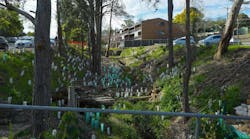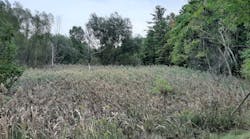Project Proile: Seeing Below the Surface
In the fall of 2003, the University of Mississippi at Oxford, or Ole Miss, opened the doors of a state-of-the-art track and field complex.
An integral part of a larger $50 million project, the facility features a nine-lane track, seating for over 1,500 spectators, and an administration building. This building houses coaches’ offices, team meeting rooms, a film room, and full men’s and women’s locker rooms. When sinkholes began to appear on the track a local engineering firm was hired to conduct a geotechnical investigation of the facility and find the root of the issue. As a result of the investigation, in April 2014 the same facility was closed down due to safety issues associated with a failed 66-inch-diameter reinforced concrete pipe (RCP) that was placed over 50 years ago.
The first indication of a possible problem occurred when small sinkholes were noticed on the turf in the area in which the javelin and discus events take place. Specifically, the point where the artificial track surface meets the infield turf is designed to have a negligible vertical transition from one to another. In this instance, noticeable vertical expressions of up to 6 inches were commonplace. Also, when there is any form of precipitation, the impermeable material of the track surface forced surficial runoff to the infield, adding significant volumes of water to the grassy areas. This, in turn, had accelerated subsurface erosion (known as “piping”), by creating narrow, subsurface conduits that grow both in diameter and length as more material is removed.
When the irregular features were noticed by members of the field staff at Ole Miss, the immediate reaction was to simply fill the holes in with sand and laser-grade the surface. Keeping the turf in a healthy green condition is important for the maintenance of the track and field facility, so a high volume of water was applied with an 800-gallon-per-minute water cannon. In this particular case, however, the procedure further exacerbated the subsurface issues. In spite of the attempts to rectify the situation, the problem continued to reappear. The filling and watering process was repeated several times, but the field continued to sink, and the University realized it had a problem on its hands.
The first order of business was to find out what was causing the anomalies, assess the damage, and establish if there was any risk involved to the welfare and safety of the staff, students, and visitors. With this in mind, a local engineering firm was called in to conduct a forensic investigation into the cause and to evaluate the situation. From a geotechnical perspective, this involved soil borings, soil classification, topographical surveying, standard penetration testing (ASTM-D1586), and videos and site photos of the inside of the storm drain suspected to be the cause of the sinkholes.
Standard penetration testing is important because it provides an indication of soil consistency and compaction. As a general rule, progress is measured at about 15 to 30 blows per foot of advancement. In the case of Ole Miss, many places met with values at fewer than five blows, indicating very loose fill materials. At one location near the southeast corner, as they were hammering away 11 feet below the surface, one blow of the dropped hammer caused the winch holding it to free spool and instantly fall an estimated 5 feet before stopping around 16 feet below the surface. This result indicated a void in the subsurface, and red flags went up. From the aspect of safety for their athletes and staff, it was clear that more information was required before an informed decision about the situation at the sports facility could be made.
The engineering firm recommended the use of ground-penetrating radar (GPR) to determine what was going on below the surface before conducting further invasive testing. On the recommendation of that firm, Mark Teague, a registered professional geologist and owner of TeaCo Geophysical, was brought in to evaluate what the university was looking at. Prior to mobilization from base, Teague ensured he was prepared for the task by carefully reading the forensic engineering report and comparing that information to site drawings that depicted the run of the 66-inch storm drain. Records showed that under the field was a network of 6-inch-diameter storm drains to ensure the grassy field had proper drainage. The 66-inch-diameter RCP descends from northwest to southeast, where the storm drain empties into a nearby creek. The storm drain can be seen undercutting the entire track area at a 45-degree angle, running under the grandstands, track office, and through the front parking lot.
Teague is a firm believer in using GPR as a viable option for nondestructive and noninvasive site analysis. As he explains, “Primarily GPR should be contracted in Phase I site analyses for the subsurface identification of potential hazards prior to invasive geotechnical site characterizations. Traditionally, the geotechnical disciplines conduct soil borings during a Phase I environmental site analysis (ESA), and then after receiving the results from the lab, will call during the Phase II aspect for GPR in order to further characterize and refine areas of concern. Well how about thinking outside the box? Why not use GPR during the initial Phase I ESA to find potential anomalies and then base your soil borings to the GPR data, with at least one boring located in a “˜normal or typical section’ for control purposes? This saves time and money, particularly in drilling costs and mobilization to the same site twice. As the concept is explained to stakeholders in Mississippi, they are embracing it and are absolutely seeing value in the refined approach.”
Using a pulseEKKO PRO GPR system, manufactured by Sensors & Software Inc., Teague collected two high-resolution survey grids: one over the track (19 meters by 100 meters) and one over the grassy area (50 meters by 75 meters). Teague performed a multiple-frequency survey of the area, as lower frequencies can penetrate the ground deeper, but with less spatial resolution. Sometimes a survey necessitates the use of two frequencies when imaging targets are at multiple depths, as in the case at Ole Miss. As a result, Teague used a 250 MHz transducer with lines spaced 50 centimeters apart to image the engineered subsurface storm drains and related structures. In an attempt to see the larger-diameter, 66-inch RCP drain into which the 6-inch drains empty, he used a 100-MHz transducer, over a grid with 1-meter line spacing.
When he began to examine the data collected from the track field, his first thought was, “This is crazy.” What appeared were sinks, some of them 15 meters across.
Upon evaluating the data Teague thought, “Lord have mercy, here’s one of these features and it’s huge; here’s another one of these features, and it’s huge; and then I get to looking and scrutinizing the data, and it turns out that the majority, probably in as much as 90% of them, there’s a storm drain.” What we also see in the cross-sectional data is the protective vault that is over the deeper, 66-inch RCP.
What the data appeared to indicate was that the cause of the sinkholes is related to both the original trenching for the installation of the storm drains, and the structural incompetence of the subgrade materials used during the backfilling, which can be described as loose to very loose sand. This sand can meet construction compaction standards yet is highly susceptible to mechanical failure when water is added. The water decreases the frictional coefficient of the sand grains and allows them to slip when under load and saturated.
Video camera surveys through the RCP show that it is collapsed in sections. The video indicated clear voids around the outside diameter of the pipe itself, providing a pathway that allows for free flow of backfilled materials. Not only do the fluids from within the RCP compromise flow into the sandy materials, but they also flow along the outside diameter of the pipe, as there is already slope present allowing for the materials to migrate away from the pipe, creating surficial depressions that TeaCo classified as a “slow subsidence sinkhole.”
TeaCo Geophysical adheres to the American Society of Civil Engineers Standard ASCE 38-02, which addresses the different levels of due diligence with subsurface utility engineering and mapping. Use of GPR indicates a Level B. Level A is the highest of due diligence, requiring the physical verification of the results of noninvasive techniques.
Teague worked with the engineers, using the GPR data to point out the location of the anomalies for further Level A investigation. They were subsequently able to corroborate the information by drilling down into the exact locations of the faults, saving both time and money.
Stressing the importance of using ground-penetrating radar as a nonintrusive, accurate, and green tool, Teague explained the need for an improved general awareness of the potential of this technology. He has given lunch-and-learn seminars to educate decision-makers about GPR and possible applications. In fact, his goal is to be able to go to an engineer and say, “OK, how many soil bores do you need to do on this site? Thirty? OK, why don’t you run GPR across where you think you want to put these bores? Then let’s take a look at some cross-sections; let’s drill one bore for control where we know we have normal sections but let the GPR dictate where to stick the next bores, because we can show you where the anomalies are. You don’t want to randomly drill your penetrations everywhere.” In this way, GPR can be used to effectively direct the more intrusive and expensive Level A investigations.
As of June 2014, the survey of the track area and the front parking lot were both complete. There is a crack from wall to wall running through the administration building, directly above where the RCP is located. The facility has been condemned based on GPR corroboration of the physical field data and soil bores. The facility has been evacuated: Coaches, students, athletes, and administration staff all have been removed, and the administration is now trying to save the building. Luckily no injuries have occurred due to the failing site.
Using GPR as a tool may not have saved the day in terms of preventing or fixing the damage at Ole Miss. It did, however, provide a clear map of the underground anomalies. It saved time and money, and it prevented environmental damage. More importantly, GPR helped ensure that the site was kept safe and no injuries occurred.


